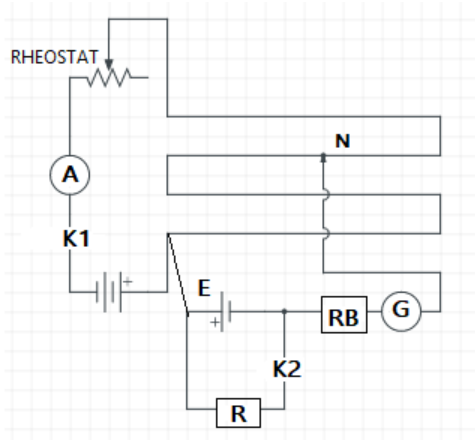
State the working principle of Potentiometer. Explain with the help of circuit diagram, how the potentiometer is used to determine the internal resistance of the given primary cell. In a potentiometer arrangement, a cell of emf \[1.25V\] gives a balance point at \[35cm\] length of the wire. If the cell is replaced by another cell and the balance point shifts to \[63cm\], what is the EMF of the second cell?
Answer
492.8k+ views
Hint: Potentiometer is a three-terminal resistor, which produces a voltage divider, through sliding or rolling contact. $r=R\left( \dfrac{{{l}_{1}}}{{{l}_{2}}}-1 \right)$ and $E=\dfrac{\rho L}{A}I=KL$, we can solve the question.
Formula used: $r=R\left( \dfrac{{{l}_{1}}}{{{l}_{2}}}-1 \right)$ and, $E=\dfrac{\rho L}{A}I=KL$
Complete step-by-step answer:
Potentiometer is a three-terminal resistor, which produces a voltage divider, through sliding or rolling contact. It works on the principle that potential across the wire depends on the length of the wire, which has uniform cross-sectional area and constant current flowing through it. It can be used to measure the internal resistance of the primary cell.

Connections are made as given in the diagram.
We know, $V=IR$ Ohm’s law. Where $I$ is current in the circuit, $R$ is the total resistance and $V$ is the voltage drop.
Also $R=\dfrac{\rho L}{A}$. Where $\rho$ is the resistivity, $A$ is the area of cross-section of the wire, $L$ is the length of the wire.
For any potentiometer $\rho\;,A$ are constant.
Then, according to the principle, $E=\dfrac{\rho L}{A}I=KL$, where $E$ is the emf of the cell and $K$ is the potential gradient.
Here $E$ is the emf of the primary cell, and $r$ is its internal resistance. To find $r$, plug in${K_{2}}$ the resistance box $R$, the potentiometer is balanced at say $l_{1}$,
Then$E=Kl_{1}=I(R+r)$.
When the plug out the $K_{2}$, when the potentiometer is balanced at say $l_{2}$, then$V=Kl_{2}=IR$
$\dfrac{E}{V}=\dfrac{ Kl_{1}}{ Kl_{2}}=\dfrac{ I(R+r)}{IR}$
$\dfrac{ l_{1}}{ l_{2}}=\dfrac{ (R+r)}{R}$
Thus $r=R\left( \dfrac{{{l}_{1}}}{{{l}_{2}}}-1 \right)$
Using the given, emf of cell= $E_{1}= 1.25V\; , l_{1}=35cm$ and $E_{2}=E\;, l_{2}=63cm$
$\dfrac{E_{1}}{E_{2}}=\dfrac{l_{1}}{l_{2}}$
$\dfrac{1.25}{E}=\dfrac{35}{63}$
$E=\dfrac{63}{35}\times 1.25=2.25 V$
Hence the emf of the unknown is 2.25 V.
Note: Clearly understand the difference between what happens when $K_{2}$ is plugged in and out. Try to remember the formula used. Remember the circuit diagram and the principle. Observe that the equations are interrelated, in terms of the potential.
Formula used: $r=R\left( \dfrac{{{l}_{1}}}{{{l}_{2}}}-1 \right)$ and, $E=\dfrac{\rho L}{A}I=KL$
Complete step-by-step answer:
Potentiometer is a three-terminal resistor, which produces a voltage divider, through sliding or rolling contact. It works on the principle that potential across the wire depends on the length of the wire, which has uniform cross-sectional area and constant current flowing through it. It can be used to measure the internal resistance of the primary cell.

Connections are made as given in the diagram.
We know, $V=IR$ Ohm’s law. Where $I$ is current in the circuit, $R$ is the total resistance and $V$ is the voltage drop.
Also $R=\dfrac{\rho L}{A}$. Where $\rho$ is the resistivity, $A$ is the area of cross-section of the wire, $L$ is the length of the wire.
For any potentiometer $\rho\;,A$ are constant.
Then, according to the principle, $E=\dfrac{\rho L}{A}I=KL$, where $E$ is the emf of the cell and $K$ is the potential gradient.
Here $E$ is the emf of the primary cell, and $r$ is its internal resistance. To find $r$, plug in${K_{2}}$ the resistance box $R$, the potentiometer is balanced at say $l_{1}$,
Then$E=Kl_{1}=I(R+r)$.
When the plug out the $K_{2}$, when the potentiometer is balanced at say $l_{2}$, then$V=Kl_{2}=IR$
$\dfrac{E}{V}=\dfrac{ Kl_{1}}{ Kl_{2}}=\dfrac{ I(R+r)}{IR}$
$\dfrac{ l_{1}}{ l_{2}}=\dfrac{ (R+r)}{R}$
Thus $r=R\left( \dfrac{{{l}_{1}}}{{{l}_{2}}}-1 \right)$
Using the given, emf of cell= $E_{1}= 1.25V\; , l_{1}=35cm$ and $E_{2}=E\;, l_{2}=63cm$
$\dfrac{E_{1}}{E_{2}}=\dfrac{l_{1}}{l_{2}}$
$\dfrac{1.25}{E}=\dfrac{35}{63}$
$E=\dfrac{63}{35}\times 1.25=2.25 V$
Hence the emf of the unknown is 2.25 V.
Note: Clearly understand the difference between what happens when $K_{2}$ is plugged in and out. Try to remember the formula used. Remember the circuit diagram and the principle. Observe that the equations are interrelated, in terms of the potential.
Recently Updated Pages
Master Class 12 English: Engaging Questions & Answers for Success

Master Class 12 Social Science: Engaging Questions & Answers for Success

Master Class 12 Chemistry: Engaging Questions & Answers for Success

Master Class 12 Economics: Engaging Questions & Answers for Success

Master Class 12 Maths: Engaging Questions & Answers for Success

Master Class 12 Biology: Engaging Questions & Answers for Success

Trending doubts
Which are the Top 10 Largest Countries of the World?

Draw a labelled sketch of the human eye class 12 physics CBSE

Differentiate between homogeneous and heterogeneous class 12 chemistry CBSE

What are the major means of transport Explain each class 12 social science CBSE

What is the Full Form of PVC, PET, HDPE, LDPE, PP and PS ?

How much time does it take to bleed after eating p class 12 biology CBSE




